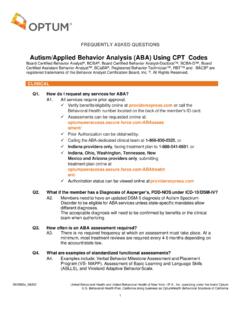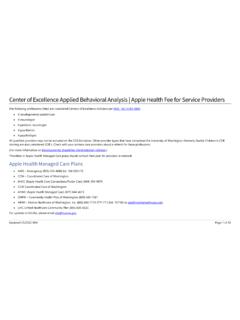Transcription of Applied Behavior Analysis Treatment of Autism Spectrum ...
1 SECOND EDITIONA pplied Behavior Analysis Treatment of Autism Spectrum Disorder:Practice Guidelines for Healthcare Funders and ManagersCopyright 2014, 2020 by The Council of Autism Service Providers ( CASP ). Ver. and/or paper copies of part of all of this work may be made for personal, educational, or policymaking purposes, provided such copies are not made or distributed for profit or commercial advantage. All copies, regardless of medium, must include this note on the first page. Abstracting with proper credit is permitted, so long as the credit reads Copyright 2020 by The Council of Autism Service Providers (CASP), all rights reserved. All other uses and/or distributions in any medium require advance permission of The Council of Autism Service Providers ( CASP ), available from standards are provided for informational purposes only and do not represent professional or legal advice.
2 There are many variables that influence and direct the professional delivery of Applied Behavior Analysis (ABA) services. The Council of Autism Service Providers (CASP) and authors of these standards assume no liability or responsibility for application of these standards in the delivery of ABA services. The standards presented in this document reflect the consensus of a number of subject matter experts, but do not represent the only acceptable practice. These standards also do not reflect or create any affiliation among those who participated in their development. CASP does not warrant or guarantee that these standards will apply or should be Applied in all settings. Instead, these standards are offered as an informational resource that should be considered in consultation with parents, Behavior analysts, regulators, and healthcare funders and OF CONTENTSPART I: OverviewSECTION 1: Executive Summary.
3 3 SECTION 2: Autism Spectrum Disorder and Applied Behavior Analysis ..4 SECTION 3: Considerations ..5 PART II: Unique Features Of Applied Behavior AnalysisSECTION 1: Training and Credentialing of Behavior Analysts ..6 SECTION 2: Applied Behavior Analysis in the Treatment of AutismSpectrum Disorder ..10 SECTION 3: Assessment, Formulation of Treatment Goals, andMeasurement of Client Progress ..19 SECTION 4: Service Authorization and Dosage ..22 SECTION 5: Tiered Service-delivery Models and Behavior Technicians ..26 SECTION 6: Case Supervision ..31 SECTION 7: Working with Caregivers and Other Professionals ..36 SECTION 8: Discharge, Transition Planning, and Continuity of Care ..40 PART III: AppendicesAPPENDIX A: Eligibility Requirements for BACB Certification.
4 41 APPENDIX B: Selected Bibliography ..44 APPENDIX C: Footnotes ..453 SECT I O N 1:EXECUTIVE SUMMARYThe purpose of this document is to inform decision-making regarding the use of Applied Behavior Analysis (ABA) to treat medically necessary conditions so as to develop, maintain, or restore, to the maximum extent practicable, the functioning of individuals with Autism Spectrum Disorder (ASD) in ways that are both efficacious and cost The document is based on the best available scientific evidence and expert clinical opinion regarding the use of ABA as a behavioral health Treatment for individuals diagnosed with ASD. The guidelines are intended to be a brief and user-friendly introduction to the delivery of ABA services for ASD. These guidelines are written for healthcare funders and managers, such as insurance companies, government health programs, employers, among others.
5 The guidelines may also be useful for consumers, service providers, and regulatory bodies. This document provides clinical guidelines and other information about ABA as a Treatment for ASD. As a behavioral health Treatment , ABA includes a number of unique clinical and delivery components. Thus, it is important that those charged with building a provider network understand these unique features of ABA. This is the second edition of this resource manual and it will continue to be periodically updated to reflect changes in clinical practice and research findings. Additional references and information can be found in the I:Overview412 SECTION 2: Autism Spectrum DISORDERAND Applied Behavior ANALYSISWhat Is ASD?ASD is characterized by varying degrees of difficulty in social interaction and verbal and nonverbal communication, and the presence of repetitive Behavior and/or restricted Due to the variability and symptom presentation, no two individuals with an ASD diagnosis are the same with respect to how the disorder manifests and its impact on families.
6 Because of the nature of the disorder, people with ASD often will not achieve the ability to function independently without appropriate medically necessary Treatment . What Is ABA?ABA is a well-developed scientific discipline among the helping professions that focuses on the Analysis , design, implementation, and evaluation of social and other environmental modifications to produce meaningful changes in human Behavior . ABA includes the use of direct observation, measurement, and functional Analysis of the relations between environment and Behavior . ABA uses changes in environmental events, including antecedent stimuli and consequences, to produce practical and significant changes in Behavior . These relevant environmental events are usually identified through a variety of specialized assessment methods.
7 ABA is based on the fact that an individual s Behavior is determined by past and current environmental events in conjunction with organic variables such as their genetic endowment and physiological variables. Thus, when Applied to ASD, ABA focuses on treating the problems of the disorder by altering the individual s social and learning environments. The current guidelines are specific to ABA as a behavioral health Treatment of ASD. Nevertheless, ABA has also been demonstrated as effective for treating the symptoms of a variety of conditions, including severe destructive Behavior , substance abuse, dementia, pediatric feeding disorders, traumatic brain injury, among successful remediation of core deficits of ASD, and the development or restoration of abilities, documented in hundreds of peer-reviewed studies published over the past 50 years, has made ABA the standard of care for the Treatment of ASD (see Appendix B).
8 5 SECTION 3:CONSIDERATIONS This document contains guidelines and recommendations that reflect established research findings and best clinical practices. However, individualized Treatment is a defining feature and integral component of ABA, which is one reason why it has been so successful in treating this heterogeneous disorder. Some individuals diagnosed with ASD have co-occurring conditions including, but not limited to, intellectual disabilities, seizure disorders, psychiatric disorders, chromosomal abnormalities, feeding disorders, sleep disorders, elimination disorders, destructive Behavior (for example, self-injury, aggression), and a variety of other conditions that require additional medical Treatment . These guidelines apply to individuals diagnosed with ASD with these co-occurring conditions, as research has established ABA as effective for these client populations as well.
9 The guidelines in this document are pertinent to the use of ABA as a behavioral health Treatment to develop, maintain, or restore, to the maximum extent practicable, the functioning of an individual with ASD. These guidelines should not be used to diminish the availability, quality, or frequency of currently available ABA Treatment services. Coverage of ABA Treatment for ASD by healthcare funders and managers should not supplant responsibilities of educational or governmental entities. Specification of ABA in an educational or government program should not supplant ABA coverage by healthcare funders and managers. ABA Treatment must not be restricted a priori to specific settings but instead should be delivered in those settings that maximize Treatment outcomes for the individual client.
10 This document provides guidance regarding ABA Treatment only; other behavioral health treatments are not addressed. 6 SECT I O N 1:TRAINING AND CREDENTIALINGOF Behavior ANALYSTSABA is a specialized behavioral health Treatment approach and most graduate or postgraduate training programs in psychology, counseling, social work, or other areas of clinical practice do not provide in-depth training in this discipline. Thus, an understanding of the credentialing process of Behavior Analysts by the Behavior Analyst Certification Board (BACB ) can assist health plans and their subscribers in identifying those providers who meet the basic competencies to practice ABA. The formal training of professionals certified by the BACB is similar to that of other medical and behavioral health professionals.







